
Welcome to manchestersnakes.com! I am David, a snake enthusiast living in Manchester, NH. Many people don't know that Manchester is in fact full of snakes! You just need to know where to find them - they can often be shy and elusive. Some New Hampshire snake species are more common outside of the city limits, in different parts of Hillsborough County NH, but many types of snakes are indeed common in the more urban parts of Manchester. This guide is meant to help educate you about the beautiful snakes of Manchester, and to help you identify the most common snakes of Manchester, as well as the venomous snakes of Manchester that you should learn to recognize and avoid. If you want more detail, click here for my complete list of ALL snake species in Manchester. Remember the following:
- Most snakes of Manchester are harmless and don't want to encounter you
- Venomous snakes exist but are uncommon in Manchester, New Hampshire
- Snakes eat rats and mice and are a valuable part of the New Hampshire ecosystem
- Never kill a snake - if you leave a snake alone, it will leave you alone.
Common Snake Species in Manchester
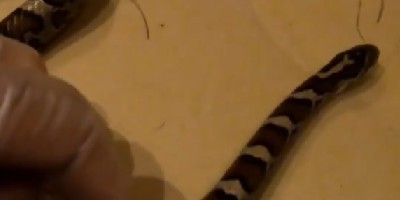 Milksnake:
The eastern milksnake (Lampropeltis triangulum triangulum) is a non-venomous type of kingsnake that is fairly large, usually growing over 24 inches (60 cm) and all the way up to 50 inches (130 cm). It has a bold color pattern that makes it easy to spot - an alternation of red, yellow, black, or white blotches. This also means it often gets mistaken for other snake species. While the milksnake is fairly slender-bodied, it can grow bulky in old age. It mostly prefers forested, rocky areas, and feeds on slugs, snails, and earthworms.
Milksnake:
The eastern milksnake (Lampropeltis triangulum triangulum) is a non-venomous type of kingsnake that is fairly large, usually growing over 24 inches (60 cm) and all the way up to 50 inches (130 cm). It has a bold color pattern that makes it easy to spot - an alternation of red, yellow, black, or white blotches. This also means it often gets mistaken for other snake species. While the milksnake is fairly slender-bodied, it can grow bulky in old age. It mostly prefers forested, rocky areas, and feeds on slugs, snails, and earthworms.
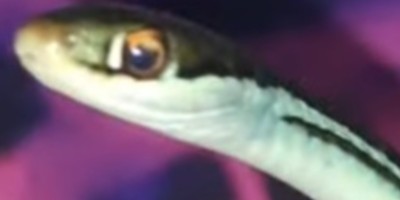 Ribbon Snake:
The ribbon snake (Thamnophis sauritus) is a fairly common species of garter snake. It’s a very slender and fairly short serpent, usually not exceeding 30 inches (90 cm) in length. It is thus named because of the three yellow/green stripes that run down its body, giving it a festive appearance. The ribbon snake is an aquatic serpent that loves hanging out near creeks, streams, lakes, and so on. Appropriately, they prey mostly on aquatic creatures (newts, fish, salamanders, etc.).
Ribbon Snake:
The ribbon snake (Thamnophis sauritus) is a fairly common species of garter snake. It’s a very slender and fairly short serpent, usually not exceeding 30 inches (90 cm) in length. It is thus named because of the three yellow/green stripes that run down its body, giving it a festive appearance. The ribbon snake is an aquatic serpent that loves hanging out near creeks, streams, lakes, and so on. Appropriately, they prey mostly on aquatic creatures (newts, fish, salamanders, etc.).
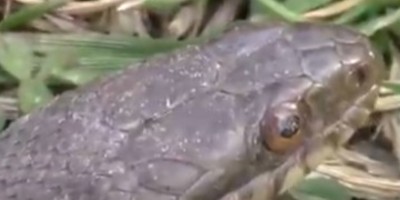 Northern Watersnake:
The northern watersnake (Nerodia sipedon sipedon) is quite often mistaken for the common watersnake (Nerodia sipedon). It is a large, non-venomous snake that, as its name suggests, prefers to spend its time near water. The northern watersnake usually grows up to 4.5 feet (135 cm) in length, although even larger specimens have been noted. Its body is bulky and it’s usually found near ponds, swamps, etc. as most water snakes are. It is a good climber and can often be found hanging off branches near water. Its base color varies, from brown to cream, to red and black, and its body is speckled with dark crossbands and blotches.
Northern Watersnake:
The northern watersnake (Nerodia sipedon sipedon) is quite often mistaken for the common watersnake (Nerodia sipedon). It is a large, non-venomous snake that, as its name suggests, prefers to spend its time near water. The northern watersnake usually grows up to 4.5 feet (135 cm) in length, although even larger specimens have been noted. Its body is bulky and it’s usually found near ponds, swamps, etc. as most water snakes are. It is a good climber and can often be found hanging off branches near water. Its base color varies, from brown to cream, to red and black, and its body is speckled with dark crossbands and blotches.
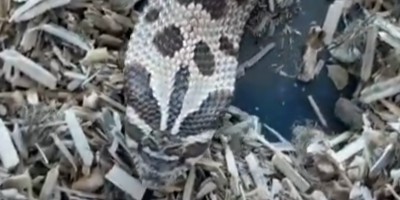 Eastern Hognose Snake:
The eastern hognose snake (Heterodon platirhinos) is an endangered species, who, although venomous, is not classified as such, since it doesn’t pose a threat to humans. It is a fairly large snake (roughly 28-30 inches, or just over 70 cm), and has a thick body. It has an upturned snout (used for digging) and its color pattern varies broadly from red, yellow, green, to brown and black. They can also have crossbands or be patternless, making them difficult to identify. The eastern hognose lives near sandy areas, open fields, or pine forests, and injects its prey (mainly amphibians) with venom.
Eastern Hognose Snake:
The eastern hognose snake (Heterodon platirhinos) is an endangered species, who, although venomous, is not classified as such, since it doesn’t pose a threat to humans. It is a fairly large snake (roughly 28-30 inches, or just over 70 cm), and has a thick body. It has an upturned snout (used for digging) and its color pattern varies broadly from red, yellow, green, to brown and black. They can also have crossbands or be patternless, making them difficult to identify. The eastern hognose lives near sandy areas, open fields, or pine forests, and injects its prey (mainly amphibians) with venom.
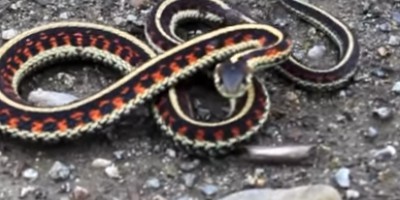 Garter Snake:
The garter snake (Thamnophis sirtalis) is a common type of non-venomous snake. It’s a small serpent, often growing to 26 inches (roughly 60 cm). It’s a highly adaptable snake, and as such, can live near water, but also in forests, open fields, and even in the back lawn. It has 2-3 light yellow stripes running down its body and may also have dark spots. Similarly to the eastern hognose snake, it uses venom (neurotoxin) to stabilize its prey but is not considered dangerous to humans, because of the very small amounts of venom released.
Garter Snake:
The garter snake (Thamnophis sirtalis) is a common type of non-venomous snake. It’s a small serpent, often growing to 26 inches (roughly 60 cm). It’s a highly adaptable snake, and as such, can live near water, but also in forests, open fields, and even in the back lawn. It has 2-3 light yellow stripes running down its body and may also have dark spots. Similarly to the eastern hognose snake, it uses venom (neurotoxin) to stabilize its prey but is not considered dangerous to humans, because of the very small amounts of venom released.
Venomous Snake Species in Manchester
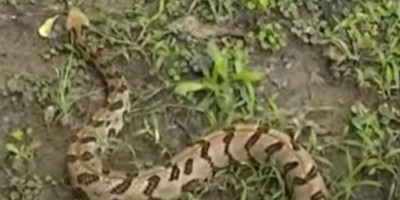 Timber Rattlesnake:
The timber rattlesnake (Crotalus horridus) is the only venomous snake to be found in the state of New Hampshire. It is an endangered species, and so, it is illegal to kill one. The timber rattlesnake is a type of pit viper that grows up to 60 inches in length (152 cm). It’s color patterns are usually really dark, leaning towards full black, which makes the brown-ish crossbands difficult to see. It generally prefers forested areas, where it can freely feed on small mammals. The timber rattler is considered one of the most dangerous snakes in the country, due to its large fangs and high venom yield, but is fairly peaceful and won’t attack unless provoked.
Timber Rattlesnake:
The timber rattlesnake (Crotalus horridus) is the only venomous snake to be found in the state of New Hampshire. It is an endangered species, and so, it is illegal to kill one. The timber rattlesnake is a type of pit viper that grows up to 60 inches in length (152 cm). It’s color patterns are usually really dark, leaning towards full black, which makes the brown-ish crossbands difficult to see. It generally prefers forested areas, where it can freely feed on small mammals. The timber rattler is considered one of the most dangerous snakes in the country, due to its large fangs and high venom yield, but is fairly peaceful and won’t attack unless provoked.
If you're unsure, you can email me a photo of the snake at info@manchestersnakes.com and I will email you back with the snake's species. If you found a snake skin, read my Found a Skin? page, and you can email me a photo of the skin, and I'll identify the snake for you. If you need professional Manchester snake removal help, click my Get Help page, or see the below website sponsor I found, who provides that service.
Remember, the term is not poisonous snakes of Manchester, it's venomous snakes of Manchester. Poison is generally something you eat, and venom is injected into you. That said, dangerous snakes are very rare in Manchester. The few venomous snakes of Hillsborough County are rarely seen. But they are commonly misidentified, so learn about all the snake species of Manchester in order to correctly identify them. These snakes are usually also found in the surrounding towns of Antrim, Nashua, Merrimack, Goffstown, New Boston, Weare, Francestown, Greenville, Milford, Peterborough, Deering, Amherst, Bennington, Hudson, Hollis, New Ipswich, Pelham, Mont Vernon, Lyndeborough, Manchester, Brookline, Litchfield, Bedford, Greenfield, Hancock, Wilton, Mason, Temple, Windsor, Sharon, and the surrounding areas.
Read our article about:
Guide on the Yellow Rat Snake
manchestersnakes.com domain and hosting costs made possible by the generous support of this sponsor:
